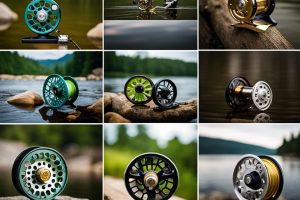Most anglers face a choice between large arbor and standard arbor fly reels. Each type offers distinct advantages and features that cater to different fishing styles and conditions. Understanding these differences will help you make an informed decision, maximizing your efficiency on the water. Whether you’re chasing trout in a mountain stream or big fish in open waters, the right reel can greatly impact your success. In this guide, you’ll find a clear comparison of both options to aid your selection process.
Design and Construction
Before choosing between a large arbor or standard arbor fly reel, it’s important to understand the differences in design and construction. The choice will influence your fishing experience. Each type has its own merits, and knowing these can help you make an informed decision. For deeper insight, check out discussions like this one on Standard vs. Large arbor reels?.
Large Arbor Reels
Arbor reels are designed for speed. With a larger spool, they pick up line faster, which can be critical when you’re fighting a fish. The wider diameter also reduces line coiling. This means you can cast with greater control and precision. Additionally, they are generally lighter, allowing for extended use without fatigue.
The construction of large arbor reels often features advanced materials. Aluminum and carbon fiber dominate this category for their strength-to-weight ratio. This ensures durability while keeping the overall weight low which is important for long days on the water. With high-quality drag systems, these reels can handle strong fish with finesse.
Standard Arbor Reels
Any discussion of fly reels wouldn’t be complete without mentioning standard arbor reels. These reels utilize a smaller spool, which can be beneficial for a smooth line retrieval. They are typically more traditional in design and can provide a sense of nostalgia for anglers. While they lack the rapid pickup of their larger counterparts, they excel in drag performance, particularly with long-running fish.
Reels of this type are usually heavier, which can affect your arm after a long day of casting. However, some anglers prefer the feel and balance of standard arbor reels, particularly in classic fishing scenarios.
While they may not boast the speed of large arbor reels, they often come with robust designs that have withstood the test of time and trends in fly fishing. This makes them a reliable choice for those who prioritize durability and a classic feel over speed.
Line Capacity and Retrieval Rate
You might be wondering about how line capacity and retrieval rate play into the performance of large arbor versus standard arbor reels. Well, these factors significantly influence your fishing experience. A reel with a larger arbor tends to hold more line, allowing you to fish deeper waters or use heavier tippets without worry. Additionally, the larger spool design typically enables a quicker retrieval rate. This can be crucial when you need to quickly reel in a fish or retrieve line after a cast. The larger the reel, the more line it can take up in each turn, making your time on the water more efficient.
Large Arbor Reels: Advantages and Disadvantages
Arbor reels come with clear advantages when it comes to line capacity and retrieval rate. Because they have a wider diameter, they can hold more line and facilitate quicker recovery after a hook set. This heightened retrieval capability helps you catch up to fast-moving fish. Moreover, the ability to hold more backing can benefit you in emergencies when a fish makes a long run. However, the larger size may make them heavier, which can be a detractor for some anglers who prefer lighter gear, especially for long days on the water.
Standard Arbor Reels: Advantages and Disadvantages
Rate of retrieval in standard arbor reels is generally slower compared to their large arbor counterparts. This can be a disadvantage when hunting active fish. However, there are upsides. Standard arbor reels tend to be lighter and can provide a more balanced feel on smaller rods. They often excel in line management and offer more delicate drag systems, which is particularly beneficial when targeting fish that require finesse and careful handling. Yet, you’ll need to be vigilant about your line during fast retrieves, as a standard arbor may not keep up when you’re trying to gain control.
Standard arbor reels still hold their ground by offering a range of line features that can be compelling, especially for those who value precision over speed. The spool’s design allows for a tighter coil of line, reducing memory issues and improving casting accuracy. While they may lack the rapid recovery of large arbor styles, they provide reliability and consistent performance, making them a solid choice for many anglers looking to hone their craft.
Weight and Balance
One key aspect to consider when choosing between large and standard arbor fly reels is how their weight and balance affect your casting and fishing experience. The design of the reel plays a crucial role in your overall performance on the water. By understanding these factors, you can select a reel that feels right in your hands and enhances your fishing prowess.
Large Arbor Reels: Impact on Casting and Fishing
Reels with large arbors are generally lighter and promote faster line retrieval. This feature allows you to get your line back in more quickly, which can be vital when you need to catch up to a running fish. The enhanced balance from a larger spool helps distribute weight more evenly, making it easier to cast for extended periods without feeling fatigued. You’ll find that each cast feels more effortless, and your accuracy improves as a result.
Additionally, the increased backing capacity of large arbor reels reduces line memory and tangles. When fishing in currents or when targeting fast-moving fish, this means you can handle unexpected runs with confidence. Your ability to adapt quickly can lead to more successful hook-ups and fewer lost fish, enhancing your overall experience on the water.
Standard Arbor Reels: Impact on Casting and Fishing
The traditional standard arbor reel features a smaller spool, which might weigh a bit more depending on its construction. While this design is often associated with classic aesthetics, it tends to have a slower line retrieval rate. This can affect your casting rhythm and the speed at which you regain control over your line during a fish fight. You may find yourself spending more energy trying to keep up with fast fish.
Balance becomes an important aspect in the standard arbor setup. The extra weight at the reel’s center can lead to a front-heavy feel, which may tire your arm during long days on the water. However, many anglers appreciate the precise control and feedback that standard arbors provide when casting delicate presentations. They excel in situations where finesse is crucial, allowing you to place your fly with remarkable accuracy.
Drag System and Performance
After considering the size and weight of fly reels, you must explore into the drag system. It’s necessary to understand how each type affects your performance on the water. The drag system governs how much resistance a fish feels when it pulls line from your reel. Both large and standard arbor reels have their strengths, but their designs lead to different experiences in the heat of battle.
Large Arbor Reels: Smooth Drag and Consistency
Performance is a standout feature of large arbor reels. Their design allows for a faster retrieve and a smoother drag, which is crucial during a fight with a fish. High-quality large arbor reels often incorporate disc drags that distribute pressure evenly across the entire surface area. This means that whether a fish is making quick runs or powerful leaps, your drag remains consistent. The ease of adjustment in these reels also provides fishermen with the capability to respond instantly to changing conditions, ensuring that you are not fighting with your gear when you should be focused on landing the catch.
Moreover, the efficiency of large arbor fishing reels comes into play when you’re trying to recover line quickly. With a larger spool diameter, you can retrieve more line with each turn of the handle. This characteristic is particularly beneficial when engaging with fast or aggressive species, where every second counts. Your experience will be enhanced as you find yourself battling fish without the constant worry of overloading your drag system.
Standard Arbor Reels: Adequate Drag and Control
Performance in standard arbor reels may not match the sheer speed of their larger counterparts, but they still provide reliable control in a variety of fishing scenarios. These reels often feature a simpler drag system that, while effective, may not offer the level of smoothness found in larger models. However, if you’re fishing in waters where delicate presentations are key, the sensitivity offered by a standard arbor reel can offer its own advantages. The drag adjustment is straightforward, allowing you to make quick changes as conditions shift.
Arbor designs of standard reels typically provide adequate drag strength, making them suitable for moderate-sized fish and light to medium applications. With their familiar construction, these reels lend themselves well to traditional fishing styles. If you’re casting small flies in a gentle stream, these reels can serve you well, offering control and finesse without the extra weight of a large arbor. Your skill can shine through, focusing on technique rather than being distracted by high-speed retrieves or overly complicated drag systems.
Price and Value
Despite the clear benefits that each type of fly reel offers, price and value remain crucial considerations when making your choice. Large arbor reels tend to come with a premium price tag. The advanced materials, innovative designs, and enhanced features that contribute to their performance often lead to a higher initial investment. If you seek efficiency and strength, it’s worth noting that these reels can enhance your fishing experience, potentially justifying the increased cost.
Large Arbor Reels: Premium Quality and Higher Cost
Any serious angler understands the importance of quality in their gear. Large arbor reels are typically engineered to deliver superior line management and faster retrieve rates. These features mean that while you pay more upfront, you also invest in longevity and performance. You’re purchasing not just a tool but a partner in your fishing pursuits. For those who prioritize performance and are willing to invest, these reels often prove their worth over time.
Standard Arbor Reels: Affordable Options and Budget-Friendly
On the other hand, standard arbor reels appeal to those mindful of their budget. These reels generally come at a lower price point, making them accessible for beginners or casual anglers. While they may lack some of the advanced features of their large arbor counterparts, standard arbor reels still offer solid performance and durability. You can find a wide range of options that cater to various skill levels without breaking the bank.
This affordability often allows you to invest in other aspects of your gear, like rods or lines. Many fly fishers, especially those just stepping into the sport, find that a standard arbor reel meets their needs effectively. It’s a chance to enjoy the thrill of fishing without overwhelming financial pressure, giving you room to grow in your craft with well-rounded equipment.
Fishing Applications and Species
Your choice of a fly reel significantly impacts your fishing experience. The right reel not only matches your fishing style but also complements the species you aim to catch. In this section, we will explore the specific applications and ideal fish types suited for both large arbor and standard arbor reels. Each offers unique benefits tailored to your needs on the water.
Large Arbor Reels: Suitable for Saltwater and Large Fish
With their ability to retrieve line quickly, large arbor reels are perfect for saltwater fishing and targeting larger species like tarpon or shark. The increased diameter allows you to pick up line faster, which is crucial during a battle with a strong fish. These reels’ drag systems are typically more powerful, helping you manage the unexpected runs of saltwater giants. The design facilitates easier line management in turbulent currents, giving you an advantage when dealing with the challenges of open water.
Large arbor reels also excel in minimizing line memory, which is beneficial when using heavier lines that often coil. This means less time untangling and more time casting. Additionally, the lightweight materials prevalent in many modern large arbor reels reduce fatigue, allowing you to extend your time on the water, ultimately increasing your catch potential.
Standard Arbor Reels: Ideal for Freshwater and Smaller Fish
Saltwater fishing requires a different approach, and standard arbor reels often shine in freshwater settings, particularly for targeting smaller fish like trout or panfish. Their design provides sufficient line management for the subtle movements and delicate presentations required in ponds and rivers. The ability to control line tension is key for keeping small hooks and flies from being swallowed whole.
Fish such as brook trout or bluegill can be caught skillfully with standard arbor reels. The smooth drag system allows for controlled fights without overwhelming smaller fish, making your experience more enjoyable. In still waters or gentle streams, these reels offer the finesse that can make a difference between a successful day on the water and going home empty-handed. Choosing the right reel enhances your targeting skills, aligning with your fishing goals and the species at hand.
To wrap up
From above, it is clear that both large arbor and standard arbor fly reels have their own unique benefits. Large arbor reels are favored for their quicker line retrieval and reduced line memory, making them ideal for fast-running fish. On the other hand, standard arbor reels offer a classic design, often preferred for their simplicity and balance, especially when fishing in slower waters. Choosing between them will ultimately depend on your fishing style and the conditions you anticipate facing.
In the end, your choice should align with your needs on the water. You might find large arbor reels advantageous if you chase fast fish or fish in open waters. Alternatively, if you focus on smaller streams or prefer a vintage feel, standard arbor reels may suit you better. You can explore more on this topic to decide what works for you by checking out this discussion on Are large arbor reels worth it.
FAQ
Q: What are the main differences between large arbor and standard arbor fly reels?
A: The primary differences between large arbor and standard arbor fly reels lie in their spool design, line retrieval rate, and weight. Large arbor reels feature a wider, larger spool that allows for quicker line retrieval, making it easier to catch fast-moving fish. They are particularly effective in situations where you need to pick up line quickly, such as during a fish fight. Standard arbor reels have a smaller spool, which can provide a more traditional feel and better line capacity for heavier lines but generally have a slower retrieval rate. Additionally, large arbor reels tend to be slightly heavier due to the increased size, while standard arbor reels are typically lighter and can balance out a rod better in certain scenarios.
Q: What advantages do large arbor reels have over standard arbor reels?
A: Large arbor reels offer several advantages, primarily through their design. One significant benefit is the increased line retrieval speed, which can minimize the chances of a fish escaping, especially when using fast-running species. Because of their larger spool diameter, large arbor reels also allow for better line management, reducing line memory and tangling issues. Furthermore, larger spools can hold more backing, which is crucial for longer fights with strong fish. The enhanced drag capabilities of many large arbor reels also provide smoother and more reliable performance during intense battles.
Q: Are there specific fishing scenarios where one type of reel is preferred over the other?
A: Yes, certain fishing scenarios can make one type of reel more advantageous than the other. Large arbor reels are often preferred in fast-moving waters or when targeting species known for their quick runs, such as trout or salmon. They are also ideal for saltwater fly fishing, where quick line retrieval can mean the difference between landing a fish or losing it. Conversely, anglers who fish in still waters or utilize techniques that require a slower approach, such as dry fly fishing in calm conditions, may find standard arbor reels more suited to their needs. Ultimately, the choice depends on the angler’s fishing style, target species, and specific conditions encountered during their fishing adventures.


